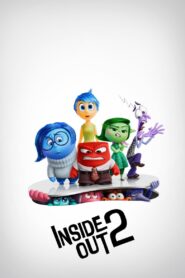
Video Sources 421 Views Report Error
Synopsis
In a city where fire, water, land and air residents live together, a fiery young woman and a go-with-the-flow guy will discover something elemental: how much they have in common.
“Elemental,” Disney and Pixar’s latest, feels emblematic of the studio’s struggle to recapture its original magic, making a mess of its world-building in service of a conventional story that fails the talent of the animators involved. Set in a world where natural elements—earth, fire, water, air—coexist in a New York-style metropolis, each representing different social classes, the film—directed by Peter Sohn, from a screenplay by John Hoberh, Kat Likkel, and Brenda Hsueh—aims high with that central metaphor but is set immediately off-balance by its unwieldiness as racial allegory, an issue compounded by haphazard pacing and writing so flatly predictable it suggests a Pixar film authored by an AI algorithm. At times bordering on the nonsensical, the film feels under-developed rather than universal, a colorful missed opportunity.
It’s not just that modern-day Pixar has focused on reprising its greatest hits with a parade of sequels (“Toy Story 4,” “Incredibles 2,” “Lightyear”), or that the studio’s slate of recent originals (“Soul,” “Luca,” “Turning Red”) have all, oddly enough, centered on characters transforming into animals (a revealing trope for its prevalence in films about feeling different, whose initially diverse protagonists invariably spend most of the runtime covered in fur or scales). Also absent lately at Pixar, a subsidiary of Disney since 2006, is the mastery of execution that had distinguished the studio, a brilliance for establishing high-concept premises and effortlessly navigating their particulars.
Presented as the closing-night selection of the 76th Cannes Film Festival, ahead of its stateside release in mid-June, “Elemental” envisions a densely populated urban sprawl similar to that of Disney’s anthrozoomorphic “Zootopia,” in which ideas of racial discrimination were uneasily reduced to “predator and prey” dynamics to allow for a story that focused more on dismantling personal prejudices than systemic racism. In Element City, a similarly ill-advised simplification is at work (though Sohn has explained that his Korean heritage and desire to make a film about assimilation fueled some of the creative decisions), and there’s even a similar eyebrow to raise with regard to the legitimate danger that these contrasting elements, like foxes to rabbits, pose to one another.
“Elemental” centers on hot-tempered Ember Lumen (Leah Lewis, of “The Half of It”), a second-generation immigrant who works as an assistant in her father’s bodega shop. Fire people who emigrated from Fireland, from whence they brought spicy food and rigid cultural traditions of honor and lineage, Ember and her father Útrí dár ì Bùrdì (Ronnie del Carmen)—though he and his wife Fâsh ì Síddèr (Shila Ommi) had their names Anglicized to Bernie and Cinder at the “Elemental” equivalent of Ellis Island—have a close relationship as he readies her to take over the family business. Ember, though, is questioning whether or not she truly wants to inherit the store, as her beloved “ashfa” says he expects, or whether her gifts—such as the ability to heat a hot-air balloon and mold glass with her hands—might lead her in another direction.
In “Elemental,” socially privileged water people flow back and forth through slickly designed high-rises and have no issue splashing down the city’s grand canals and monorails, which were designed for their gelatinous-blob bods, whereas fire folk are sequestered to Firetown, where their tight-knit community reflects East Asian, Middle Eastern, and European traditions—and accents run the gamut from Italian to Jamaican, Iranian, and West Indian, in a way that uncomfortably positions fire as representative as all immigrants and water as representative of the white upper-class. Earth and air, meanwhile, barely register; we see earth people who sprout daisies from their dirt-brown armpits, and cotton candy-esque cloud puffs playing “airball” in Cyclone Stadium, but the film is surprisingly non-committal in imagining the chemistry of inner-city elements interacting. Background sight gags abound, such as the “hot logs” that fire folk chow down on, but the actual ins and outs of Element City are explored only superficially, such as the revelation that all these elements take advantage of the same public transit. Replete with computer-generated inhabitants and generic modernist structures, its milieu feels more like concept art, to be further detailed at some point in the animation process, than a fully thought-through, lived-in environment.
Original title Elemental
IMDb Rating 7.1 23,288 votes
TMDb Rating 7.6 596 votes
Director
Director
Cast
Ember Lumen (voice)
Wade Ripple (voice)
Bernie Lumen (voice)
Cinder Lumen (voice)
Gale (voice)
Brook Ripple (voice)
Clod (voice)
Harold (voice)
Flarrietta (voice)
Fern (voice)
Comments are closed.
































